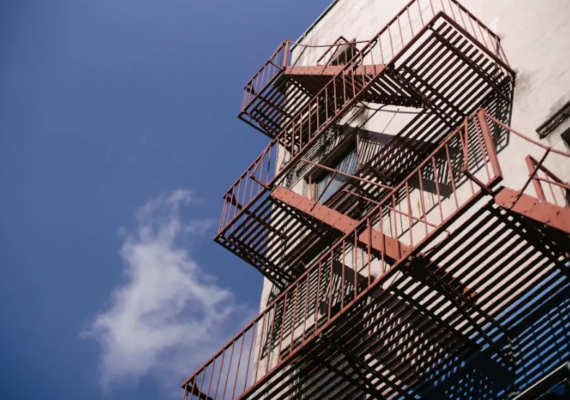15 Common Rust-related Issues In Fire Escapes And How To Fix Them

Fire escapes are critical safety features in buildings, providing an emergency escape route during fires. However, their exposure to the elements makes them susceptible to rust, which can compromise their structural integrity and safety. Understanding common rust-related issues in fire escapes and knowing how to address them is essential for building maintenance and safety.
1. Understanding the Causes of Rust in Fire Escapes
Exposure to weather conditions, particularly moisture and air, can lead to oxidation of metal surfaces, causing rust. Understanding these factors is key to preventing and addressing rust issues. In areas with high humidity or frequent rain, fire escapes are more susceptible to rust, especially in coastal regions where the salt content in the air can accelerate corrosion. Regular inspections and maintenance, as advised in the detailed guide for fire escape maintenance, can help mitigate these risks and prolong the lifespan of your fire escape.
Another significant contributor to rusting in fire escapes is the lack of protective coatings. Metal that is inadequately painted or coated is far more likely to corrode over time. Scratches and chips on the surface can provide points for moisture to penetrate, leading to the initial onset of rust. Addressing these minor defects as soon as they appear is a critical strategy in maintaining fire escape safety.
2. Identifying Early Signs of Rust
Learn to spot early signs of rust, such as discoloration and flaking paint, that could indicate deterioration, allowing for timely intervention. Faint orange or brown stains often appear on the surfaces of metal components, suggesting that oxidation is beginning. Catching rust at this stage can generally save effort and repair costs. A simple visual check is a practical first step, but engaging a professional inspection for a thorough analysis will ensure no detail is overlooked.
Regularly checking the joints, weld spots, and any protruding bolts is also crucial. These areas tend to accumulate moisture, subsequently becoming the first spots where rust might develop. Immediate action is essential if these components show rust, as they can affect the structural integrity when left unchecked for a comprehensive inspection routine.
3. The Impact of Rust on Structural Integrity
Rust can weaken the metal components of fire escapes, affecting their load-bearing capacity and overall safety. It’s crucial to assess the extent of damage and address it swiftly. As rust progresses, it converts the metal into weaker materials, compromising the structural soundness of critical elements like beams and treads. This deterioration poses a significant risk during emergencies, where the escape’s ability to bear weight and provide a safe exit route becomes paramount.
If a fire escape has extensive rust damage, sections may need reinforcement or parts may need complete replacement. Consulting with fire escape experts for a detailed assessment can be beneficial, professional services can identify the weak spots and employ the best repair techniques for durable results.
4. Surface Rust vs. Deep-Seated Corrosion
Differentiate between surface rust that can be easily removed and deeper corrosion that may require more extensive repair or replacement. Surface rust is usually less severe and can be treated with rust converters or abrasives, followed by a protective coating. However, deeper corrosion might indicate a structural issue, requiring professional evaluation and potentially significant repairs. Understanding the difference is vital to efficiently manage repair costs.
Surface rust often appears in small isolated patches, whereas deep-seated corrosion may present as extensive spalling of material. Examine all aspects of the fire escape, including underneath stair treads and railings, to detect these more severe forms of decay early on.
5. DIY Rust Removal Techniques
Explore simple and effective do-it-yourself methods for removing rust, including the use of wire brushes, sandpaper, and rust converters. These tools aid in scrubbing off loose rust effectively. Rust converters, a practical solution, chemically convert rust into a stable compound, halting further oxidation and creating a paintable surface. Investing in compatible primers and sealants is recommended to ensure the longevity of the repairs post-rust removal, a strategy advocated in maintenance tips from fire escape contractors.
It’s also important to consider the safety precautions during the removal process, ensuring you’re wearing protective gloves and a mask when dealing with chemicals or sanding rust. Keeping the area well-ventilated is crucial to prevent inhalation of particles or fumes.
6. When to Hire Professional Rust Removal Services
Identify situations where professional help is necessary, such as severe corrosion or large-scale rust removal, ensuring high-quality and safe restoration. Extensive corrosion might affect the core structural elements, making it critical to consult experts who can accurately assess and rectify the issues. Professional services offer advanced solutions like sandblasting or specialized rust inhibitors that provide long-term protection against future oxidation. Such interventions are essential when fire escapes are beyond the scope of DIY repairs, as explained in this guide on refurbishing fire escapes.
Besides the technical expertise, professionals can ensure that all maintenance complies with local safety regulations, mitigating the risk of potential liabilities. This compliance is especially important in commercial properties where the law mandates regular safety checks and certificates.
Why use Us?
Certifying fire escapes with a focus on your safety in the event of an emergency.
East Coast Fire Escapes is one of the Eastern Seaboard’s leading fire escape companies that can take care of all your fire escape needs. Whether you have received a violation from the city or just want to make sure your fire escape is safe, East Coast Fire Escapes is ready to help make a complicated process easy and affordable. Our team is knowledgeable and has over ten years’ experience working in the industry. Our goal is to keep every fire escape in safe working order and to assist building and homeowners through the process of repairing and maintaining their fire escapes.
Contact us today or call us (551) 697-8643 to schedule a repair or scrape and paint quote. Estimates are always FREE.